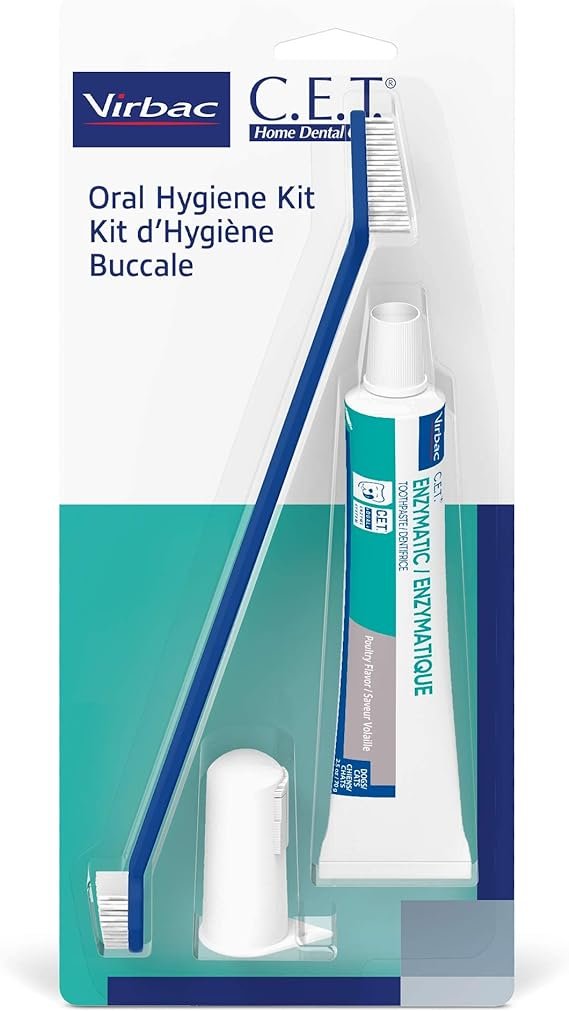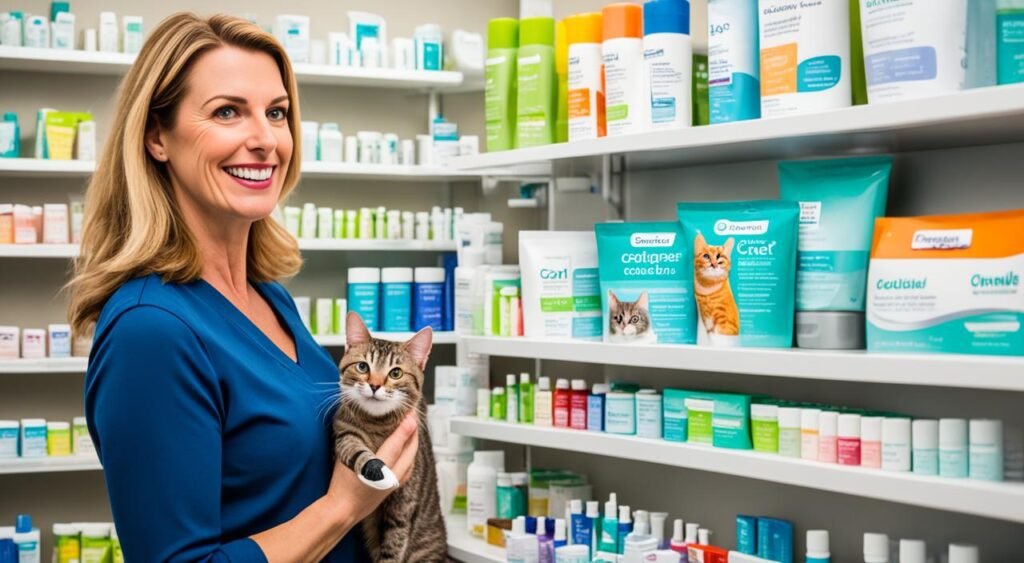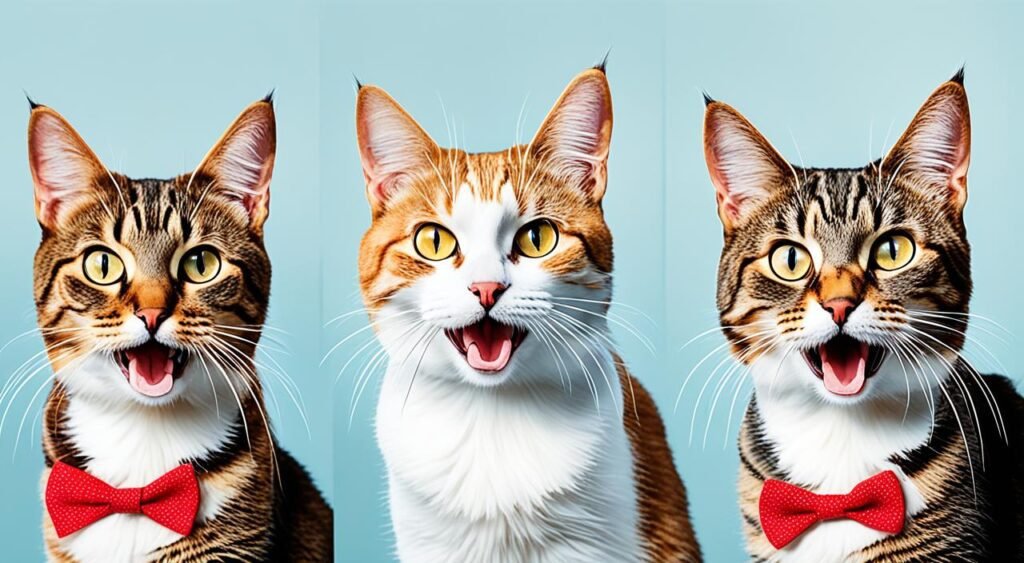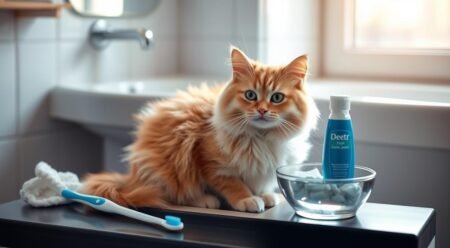Have you ever looked inside your cat’s mouth? Teeth are vital for their hunting skills. They also show how healthy your cat is. Let’s dive into cat dental care and the secrets of a cat teeth diagram. You’ll learn about keeping your cat’s teeth clean. This will keep your kitty smiling brightly.
Let’s boost your feline dental care knowledge. A good dental routine means happier and more active cats. By understanding a cat teeth diagram, you’ll keep your cat’s mouth healthy. Join us to find out how to prevent gum disease.
The Essential Guide to Feline Dental Anatomy
Understanding your cat’s dental anatomy is key to their health. Cats have teeth designed for different tasks, like catching prey and chewing meat. This article will delve into the feline dental anatomy, show you a cat tooth chart, and explain the types of cat teeth. With this knowledge, you can keep your cat’s smile bright and healthy.
Understanding Periodontal Disease in Cats
Periodontal disease is widespread in cats and can cause major health issues. It starts with plaque buildup and leads to tartar. This results in gum inflammation and can destroy the tissues and bones that hold teeth in place. To avoid this, ensure your cat gets regular dental check-ups and proper oral care.
Identifying Signs of Tooth Resorption and Cavities
Cats often face tooth resorption and cavities. Tooth resorption is where the tooth structure breaks down, potentially causing tooth loss. Cavities, less common in cats, can still occur without noticeable signs. Keeping an eye on your cat’s dental health lets you catch these problems early.
Consequences of Neglected Feline Oral Hygiene
Neglecting dental care in cats leads to more than bad breath. Mouth infections can spread, affecting organs like the heart and kidneys. It’s crucial to have a daily dental care routine for your cat’s overall health.
To show the role of different teeth, we’ll look at this table:
| Tooth Type | Number Present | Primary Function |
|---|---|---|
| Incisors | 12 | Grip and nibble food items |
| Canines | 4 | Grip and tear prey |
| Premolars | 10 | Shear and grind food |
| Molars | 4 | Grind food before swallowing |
This chart helps spot dental problems and talk effectively with your vet. Good dental care prevents diseases and health issues.
In conclusion, knowing about feline dental anatomy is crucial for your cat. Using a cat tooth chart and understanding the types of cat teeth helps keep your cat healthy and happy.
Common Cat Dental Issues and Their Symptoms
It’s key to know about your cat’s dental health to keep them happy. Not knowing the signs of dental problems can lead to worse oral diseases. Let’s look at common dental issues, their signs, and what ignoring them means.

Virbac C.E.T. Oral Hygiene Kit for Cats and Dogs | 3 Piece Set with Dual Ended Toothbrush, Fingerbrush, and Poultry Flavor 2.5 oz tube of Toothpaste | Remove Plaque & Tartar Buildup
Complete kit to start a program of regular oral hygiene for pets
Understanding Periodontal Disease in Cats
Periodontal disease often causes tooth loss and pain in cats. It begins with plaque, turns into tartar, and inflames the gums. If ignored, teeth structures weaken. Signs include:
- Red and swollen gums
- Bleeding gums
- Breath odor
- Difficulty in eating
Identifying Signs of Tooth Resorption and Cavities
Many cats face the painful issue of tooth resorption, though its cause is unclear. Symptoms are similar to human cavities. Look for these warning signs:
- Visible pits or holes in the teeth
- Gums growing into the teeth
- Drooling, which may contain blood
- Pawing at the mouth or face
Cavities are rarer in cats but don’t ignore them. Spotting any sign means it’s vet time. Cats hide pain well, so watch closely.
Consequences of Neglected Feline Oral Hygiene
Ignoring dental issues can cause big health problems. Bad oral health can lead to organ damage and malnutrition. Here’s why:
Regular dental care and vet visits keep your cat healthy. If unsure, always ask your vet for dental care advice.
Cat Teeth Diagram: Deciphering Your Feline’s Oral Structure
Getting to know your cat’s mouth begins with a detailed cat teeth diagram. This dental chart is like a map that guides pet owners through understanding their feline’s tooth structure. It’s key in providing top-notch oral care for your pet.
Learning about a cat dental chart means knowing each tooth’s role. Cats have different teeth for cutting, tearing, or grinding food. A cat dental chart names each tooth and its purpose, helping you understand your cat’s mouth better.
A cat usually has 30 teeth, each set for their hunter ways. To fully grasp your cat’s dental health, we’ll look at these teeth and their roles:
- Incisors are small front teeth for grooming and nibbling.
- Canines are sharp, long teeth for holding and tearing prey.
- Premolars sit behind canines to help shred meat.
- Molars are flat teeth at the back for grinding food.
Understanding feline dental structure means noticing signs of dental problems early. Analyzing the cat teeth diagram helps spot changes in teeth or gums. These could show dental issues.
| Tooth Type | Location | Function | Common Issues |
|---|---|---|---|
| Incisors | Front of Mouth | Grooming, Nibbling | Plaque Build-up |
| Canines | Corner of Mouth | Holding, Tearing | Gum Disease, Wear |
| Premolars | Mid-Mouth | Shredding | Fractures, Tartar |
| Molars | Back of Mouth | Grinding | Tooth Decay, Loss |
Dental issues can vary by breed or be unique to each cat. Using a cat teeth diagram and regular vet visits help keep your cat’s teeth healthy. You’re now ready to look after your cat’s dental health and overall wellbeing.
Effective Daily Dental Care Techniques for Cats
Keeping your cat’s teeth healthy is more than a yearly vet visit. It requires a cat dental care routine with daily teeth brushing for cats. We’ll show you essential steps to keep your cat’s mouth healthy and help you pick the best choosing dental care products for cats. Simple daily habits can greatly improve your cat’s health.
The Importance of Regular Teeth Brushing
Brushing your cat’s teeth might seem hard at first. But with time and patience, it becomes easier for both of you. Starting a daily teeth brushing for cats routine can stop plaque and tartar. It also prevents gum disease and makes your cat’s breath fresher! Start with short brushing times. Use a finger brush or soft cat-specific toothbrush and cat toothpaste.

Choosing the Right Dental Care Products
Choose choosing dental care products for cats that vets recommend. They should fit your cat’s mouth well. There are many options, but they are not all the same. Pick soft-bristled toothbrushes and cat-safe toothpaste. Human toothpaste can hurt them. Also, dental treats can help control plaque and satisfy your cat’s need to chew.
Integrating Dental Health into Your Cat’s Routine
Make dental care a regular part of your cat’s life. Stick to a routine. Clean their teeth at the same time daily and reward them afterward. It helps your cat feel good about brushing. A solid cat dental care routine protects against dental problems. It keeps your cat’s teeth and gums healthy over time.
| Dental Product | Use Case | Benefits |
|---|---|---|
| Enzymatic Toothpaste | Daily brushing | Helps break down plaque and tartar |
| Soft Bristled Toothbrush | Gentle cleaning | Safe for enamel and gums |
| Dental Treats | Treat or reward | Controls plaque and freshens breath |
| Dental Wipes | Quick clean-ups | Convenient, reduces bacteria |
Professional Dental Treatments and When to Seek Them
A healthy cat smile is adorable, but there’s more to it than brushing. Professional dental treatments for cats are key for total mouth health. These should be done during regular veterinary dental care visits. They help keep your cat’s teeth clean and prevent future issues.
Wondering when to get a cat dental cleaning? If your cat has bad breath, trouble eating, or tartar, it’s time. Professionals can clean spots that regular brushing might miss. This means a deeper clean for your cat.
- Enhanced oral health and prevention of periodontal diseases
- Elimination of bacteria that can lead to systemic issues
- Professional scaling and polishing
- Detailed oral examination under anesthesia
- Identification and treatment of dental problems at an early stage
Let’s look at what professional vet dental care includes:
| Procedure | Description | Benefits |
|---|---|---|
| Dental Examination | A comprehensive check-up to assess oral health and detect issues. | Early identification of problems such as gum disease or tooth resorption. |
| Teeth Cleaning | Removal of plaque and tartar, both above and below the gumline. | Prevents periodontal disease and can improve overall health. |
| Digital Dental X-rays | Imaging to evaluate tooth and bone structure not visible to the naked eye. | Allows for accurate diagnosis and treatment planning. |
| Tooth Extractions | Surgical removal of teeth that are damaged or causing pain. | Relieves discomfort and prevents the spread of infection. |
Regular veterinary dental care stops big and painful problems later. Professional check-ups keep their mouth healthy. They can enjoy their daily life with no pain.
Not sure about your cat’s dental health? Talk to your vet. They’ll tell you when it’s time for a professional cleaning. And they’ll help keep your cat’s smile bright. Taking care of your cat’s teeth means a happier, healthier pet.

Nutritional Support for Healthy Cat Teeth and Gums
Just like you need a balanced diet for good dental health, your cat’s teeth and gums benefit from what they eat. Providing a cat dental health diet helps keep your pet’s smile bright. It also boosts their overall well-being. You play a big role in making sure they get the right nutrients for their mouth health. Some foods are made to help clean your cat’s teeth. They can also give them vitamins and minerals to make enamel stronger and keep gums healthy.
When looking at nutrition for cat’s teeth and gums, go for high protein and low carb diets. Carbs can lead to more plaque. Dental health cat food often has special kibble that helps scrape off plaque and tartar as your cat eats. These foods also have the right amounts of calcium and phosphorus for strong teeth. Plus, they’re rich in omega-3 and omega-6 fatty acids. These fats help keep gums healthy by fighting off dental diseases.
Choosing the right dental health cat food is not about the price. It’s about finding food that really helps with dental health. Look for foods that have the Veterinary Oral Health Council (VOHC) seal. This means the food meets high standards for reducing plaque and tartar. By choosing carefully what your cat eats, you’re taking care of their dental health. This is key to keeping them happy and purring by your side.
FAQ
Why is cat dental care important?
Dental care is key for a cat’s health. It stops mouth diseases and keeps their teeth and gums healthy.
What types of teeth does a cat have?
Cats have various teeth like incisors, canines, premolars, and molars. Each plays a unique role in their mouth.
What are the common dental issues in cats?
Cats often face dental problems like gum disease, tooth resorption, and cavities. Not caring for their teeth can cause these issues.
How can a cat teeth diagram help cat owners?
A cat teeth diagram shows the layout of a cat’s mouth. It helps owners know the teeth types and their uses.
How often should I brush my cat’s teeth?
Brushing your cat’s teeth should be a regular activity. Try to do it daily to keep their teeth healthy.
What dental care products should I use for my cat?
For your cat, pick toothpaste, toothbrushes, and treats made for their dental care. These products help keep their mouth clean.
When should I seek professional dental treatments for my cat?
You should have regular vet check-ups for your cat. Professional care is needed for serious dental issues or for a deep clean.
How does nutrition affect a cat’s dental health?
Good nutrition is vital for your cat’s dental health. Feed them food that supports dental health along with the right nutrients.








